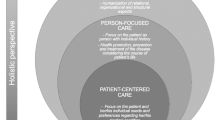Abstract
The goals of the study were to describe the clients of home care and their care providers; to determine the competencies required to provide their care; to determine the costs of the formal care providers per client diagnoses; and to determine the burden of care for a randomly selected sample of informal care providers. Forty-nine percent of the 773 clients who participated in the study were age 70 and older and 63% were female. Forty-one percent of clients lived with a spouse but 24% lived alone. The most frequent primary diagnoses (reason for admission to program) were arthritis, stroke, fractures and sepsis. Discipline experts determined the competencies required to provide the care. Variations in costs across the same diagnosis were related to the category of providers assigned and to the frequency of provision of care strategies. The constant dependency of the client was perceived as the greatest stressor for informal providers.
Résumé
Les objectifs de l’étude comprenaient: l’établissement du profil des clients des soins à domicile, la détermination des compétences nécessaires à la prestation des soins, l’évaluation des coûts des interventions et du fardeau sur les soignants du milieu. Quarante-neuf pour cent des 773 clients étaient âgés de 70 ans et plus et 63 % étaient des femmes. Quarante et un pour cent vivaient avec conjoint, alors que 24 % vivaient seuls. Les plus courants diagnostics primaires, motivant l’admission au programme, sont l’arthrite, les accidents cérébraux vasculaires, les fractures et la septicité. Les compétences nécessaires à la mise en oeuvre de stratégie de soins ont été déterminées par des spécialistes dans leur domaine. Les variations des coûts pour un même diagnostic est en fonction de la fréquence des soins et de la catégorie des fournisseurs. La dépendance constante du client était perçue comme le facteur de stress le plus important chez les soignants du milieu.
Similar content being viewed by others
References
Health and Welfare Canada. A framework for the development of home care in Canada. Report of the Federal-Provincial-Territorial-Subcommittee on Long Term-Care. 1986.
Health and Welfare Canada. Report on Home Care. 1990.
Health Services Utilization and Research Commission. The Cost Effectiveness of Home
Saba V. Home healthcare classification. Caring 1992;11(5):58–60.
Havens B. Who uses long-term care? In: E. Sawyer, M. Stephenson (Eds.), Continuing to Care: The Issues & Challenges for Long Term Care. Ottawa: Canadian Health Association, 1995.
Caserta M, Lund D, Wright S. Exploring the caregiver burden inventory (CBI): Further evidence for a multidimensional view of burden. Int J Aging Hum Dev 1996;43(1):21, 34.
Ernst R, Hay J. The US economic and social costs of Alzheimer’s disease revisited. Am J Public Health 1994;84(8):1261–64.
Turner J, Larson E, Kornievicz D, et al. Consistency and cost of home wound management by contract nurses. Public Health Nursing 1994;11(5):337–42.
Wills E, Sloan H. Assessing peripheral arterial disorders in the home: A multidisciplinary clinical guide. Home Healthcare Nurse 1996;14(9):669–80.
Canadian Association of Community Care. Canada Home Care Labour Market Study.
MacAdam M. Home care reimbursement and effects on personnel. The Gerontologist 1993;33(1):55–63.
Zarit S, Zarit J. The Memory and Behavior Problems Checklist and the Burden Interview. Pennsylvania: College of Health and Human Development, Gerontology Center, 1990.
Gallagher D, Rappaport M, Benedict A, et al. Reliability of selected interview and self-report measures with family caregivers. New Orleans, LA: Gerontological Society of America, 1985. Paper presented.
Whitlatch CJ, Zarit S, von Eye A. Efficacy of interventions with caregivers: A reanalysis. The Gerontologist 1991;31:9–18.
Health Services Restructuring Commission. Ottawa-Carleton Health Services Restructuring Report. Ontario, 1997.
Author information
Authors and Affiliations
Rights and permissions
About this article
Cite this article
Alcock, D., Danbrook, C., Walker, D. et al. Home Care Clients, Providers and Costs. Can J Public Health 89, 297–300 (1998). https://doi.org/10.1007/BF03404478
Received:
Accepted:
Published:
Issue Date:
DOI: https://doi.org/10.1007/BF03404478




